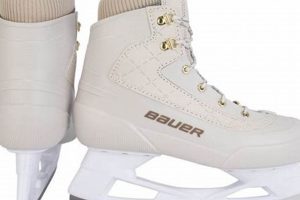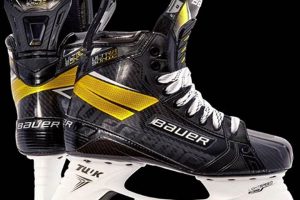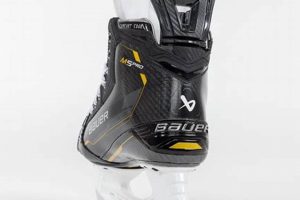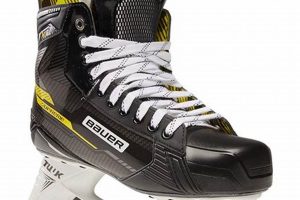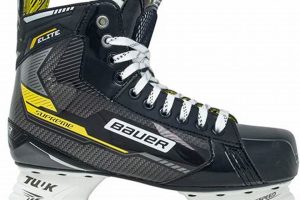Equipment worn by ice hockey goaltenders to protect and enhance mobility in the net is a critical component of their performance. The footgear, specifically designed for this unique position, offers support, protection, and blade integration for efficient skating and crease movement. These specialized boots are engineered to withstand the rigors of repeated impacts and lateral movements.
Proper fitting and technologically advanced designs contribute significantly to a goaltender’s agility, reaction time, and overall confidence. Historical developments in materials and construction techniques have led to lighter, more durable, and more customizable options for athletes at all levels. These advancements have greatly improved the performance and safety of goaltenders.
The following sections will delve into the specific features, fitting considerations, and technological innovations found in modern goaltending footgear, offering a comprehensive overview of how these factors contribute to peak performance on the ice.
Selection and Maintenance of Goaltending Footwear
The following provides guidance on selecting and maintaining specialized footwear for optimal performance and longevity.
Tip 1: Prioritize Fit. A snug, comfortable fit is paramount. Ill-fitting equipment can hinder movement and compromise stability. Consult a qualified fitter for accurate sizing and personalized recommendations.
Tip 2: Consider Blade Holder Technology. Different blade holder designs offer varying degrees of responsiveness and agility. Research available options and select a model that aligns with the goaltenders playing style and preferences.
Tip 3: Evaluate Boot Stiffness. The boot’s rigidity affects energy transfer and support. A stiffer boot typically provides more support, while a more flexible boot offers enhanced mobility. Choose a stiffness level that balances support and agility based on the individual’s needs.
Tip 4: Inspect Regularly for Damage. Routinely examine the boot, blade holder, and rivets for signs of wear and tear. Address any damage promptly to prevent further deterioration and potential injury.
Tip 5: Dry Thoroughly After Each Use. Moisture can degrade materials and lead to odor buildup. Remove the footbed and allow the boot to air dry completely after each session.
Tip 6: Replace Blades as Needed. Worn or damaged blades can negatively impact skating performance. Sharpen blades regularly and replace them when they become excessively worn or damaged.
Tip 7: Utilize Proper Storage Techniques. Store the equipment in a well-ventilated area away from direct sunlight and extreme temperatures to prevent material degradation.
Adhering to these recommendations will help ensure optimal performance, extend the lifespan of the equipment, and minimize the risk of injury.
The following section will provide an overview of specific models and technologies currently available in the market.
1. Ankle Support
Ankle support is a critical component in goalie skates, directly influencing a goaltender’s stability, mobility, and overall performance. The design and construction of the ankle support system within the skate boot is specifically engineered to withstand the unique demands of the position.
- Lateral Stability
The primary role of ankle support is to prevent excessive ankle roll during lateral movements. This is crucial for maintaining a solid stance while moving across the crease to track the puck. Insufficient lateral support can lead to instability, slower reaction times, and an increased risk of injury. The design features stiff materials and strategic padding placement to maximize stability.
- Energy Transfer
Ankle support contributes to efficient energy transfer during pushes and movements. A well-supported ankle allows the goaltender to effectively translate leg power into quick, controlled movements. A soft or inadequate ankle support system diminishes energy transfer, resulting in reduced agility and decreased responsiveness. Reinforced materials and snug fit are key to optimizing energy transfer.
- Impact Protection
The ankle joint is vulnerable to impacts from pucks, skates, and falls. The ankle support structure within the goalie skate is designed to absorb and dissipate these impacts, reducing the risk of injury. High-density foams and strategically placed protective elements are commonly incorporated to provide impact protection.
- Customization and Fit
Achieving the correct fit around the ankle is essential for optimal support and comfort. Many modern feature heat-moldable materials that allow for a customized fit, conforming to the unique contours of the goaltender’s ankle. This personalized fit maximizes support, minimizes discomfort, and improves overall performance.
The relationship between ankle support and overall performance underscores its significance. Advanced materials, design innovations, and customization options all contribute to enhancing this crucial aspect of goalie skate technology, directly influencing a goaltender’s ability to perform at their best.
2. Blade Holder Design
The blade holder, a critical component of the Bauer goalie skate, directly influences agility, responsiveness, and energy transfer on the ice. The holder’s design dictates the angle of attack, blade pitch, and overall stability of the skate, affecting a goaltender’s ability to execute precise movements. For instance, a lower profile holder facilitates tighter turns and quicker transitions, allowing for faster reactions to rapidly changing game situations. Conversely, a taller holder may provide enhanced stability for larger goaltenders or those with a more traditional playing style. The integration of lightweight materials in the holder’s construction minimizes overall skate weight, reducing fatigue and maximizing agility.
Consider the example of the Vertexx Edge holder found on several Bauer models. This design allows for quick blade changes, a valuable feature in competitive play where damaged blades can be replaced swiftly without requiring the use of tools or specialized equipment. The specific geometry of the Vertexx Edge also influences the skate’s responsiveness, impacting the speed and precision with which a goaltender can move across the crease. Further, the materials employed in the holder’s manufacturetypically high-grade plastics or composite materialscontribute to both its durability and its ability to withstand the stresses of repeated use and impacts.
Ultimately, the blade holder design is an integral factor in determining the performance characteristics of Bauer goalie skates. Understanding the nuances of different holder designs allows goaltenders to select equipment that best suits their individual needs and playing style. While other factors such as boot stiffness and ankle support are also crucial, the blade holder’s direct link to skating performance establishes it as a primary consideration in the selection process. Choosing the correct blade holder design can substantially impact a goaltender’s efficiency and effectiveness on the ice.
3. Boot Stiffness
Boot stiffness in Bauer goalie skates is a critical design parameter influencing a goaltender’s performance. The degree of rigidity directly affects energy transfer, stability, and responsiveness, ultimately impacting a player’s agility and control within the crease.
- Energy Transfer Efficiency
Stiffer boots optimize energy transfer from the goaltender’s leg muscles to the ice. This efficient transmission allows for quicker pushes and more powerful strides, enabling faster lateral movements and improved reaction times. Conversely, a boot that is too flexible absorbs energy, diminishing the power and speed of movements. The choice of boot stiffness should align with the goaltender’s skating style and power output; more powerful skaters generally benefit from stiffer boots.
- Ankle Support and Stability
Boot stiffness plays a crucial role in providing ankle support and maintaining stability, particularly during lateral movements and when absorbing impacts. A stiffer boot resists twisting and bending, preventing excessive ankle roll and minimizing the risk of injury. This enhanced stability is essential for maintaining balance and control while tracking the puck and reacting to shots. Goalies that require more ankle support to feel confident should consider a boot with a higher stiffness rating.
- Responsiveness and Control
The stiffness of the boot affects the skate’s responsiveness to the goaltender’s movements. A stiffer boot provides a more direct connection to the blade, allowing for quicker turns and more precise control. This responsiveness is particularly important for making split-second adjustments and executing complex movements within the confined space of the goal crease. Goaltenders should carefully consider the balance between responsiveness and comfort when selecting boot stiffness; overly stiff boots can reduce feel and increase fatigue.
- Impact Protection
Stiffer boot materials offer increased protection against impacts from pucks and skates. The rigid structure of the boot helps to dissipate energy from impacts, reducing the risk of bruising and fractures. This protective quality is particularly important in the high-impact environment of the goal crease, where goaltenders are frequently exposed to shots from close range. Manufacturers use advanced composite materials to achieve a high degree of stiffness while minimizing weight, balancing protection with agility.
In conclusion, boot stiffness is a key factor in optimizing the performance and protection offered by Bauer goalie skates. A careful balance between energy transfer, stability, responsiveness, and impact protection should be considered when selecting a boot stiffness level, taking into account the goaltender’s individual skating style, strength, and comfort preferences. The interaction between boot stiffness and the overall design of the skate contributes significantly to the goaltender’s ability to perform effectively and safely on the ice.
4. Heat Moldability
Heat moldability is a significant feature in Bauer goalie skates, allowing for a customized fit that enhances comfort, performance, and protection. This technology enables the skate boot to be shaped to the individual contours of the goaltender’s foot, addressing common fit issues and optimizing the interface between the skate and the player.
- Customized Fit and Comfort
Heat moldability ensures a personalized fit by allowing the skate’s internal materials to conform precisely to the goaltender’s foot shape. This eliminates pressure points, reduces discomfort, and minimizes the risk of blisters or other foot-related issues. The custom fit optimizes comfort, allowing the goaltender to focus on performance without distraction.
- Enhanced Performance
A snug, form-fitting skate optimizes energy transfer during skating movements. By minimizing slippage within the boot, heat moldability allows for more efficient strides and quicker reactions. This improved energy transfer enhances agility and responsiveness, providing a competitive advantage.
- Improved Protection
A properly molded skate ensures that the foot is securely positioned within the boot, maximizing the effectiveness of the protective elements. A customized fit reduces the likelihood of the foot shifting during impacts, enhancing the skate’s ability to absorb and dissipate energy from pucks, skates, or falls.
- Addressing Fit Irregularities
Heat moldability is particularly beneficial for goaltenders with unique foot shapes or pre-existing fit issues. The ability to customize the skate’s internal contours allows for accommodation of bunions, bone spurs, or other anatomical variations, ensuring a comfortable and supportive fit that would otherwise be difficult to achieve.
The integration of heat moldable technology in Bauer goalie skates represents a commitment to optimizing performance and protection through personalized fit. This feature enhances comfort, maximizes energy transfer, and improves the overall skating experience for goaltenders at all levels. By enabling a custom fit, heat moldability addresses individual needs and ensures that the skate performs as an extension of the athlete’s body.
5. Protective Construction
Protective construction is a paramount element within Bauer goalie skates, directly mitigating the risks associated with the high-impact environment of ice hockey. The design and materials employed are engineered to safeguard the goaltender’s feet and ankles from pucks, skates, and falls, reducing the potential for injury. The effectiveness of this protective construction is a critical factor in a goaltender’s confidence and ability to perform at their peak. Without adequate protection, a goaltender’s focus may shift from stopping the puck to avoiding injury, leading to decreased performance and potential long-term physical consequences. For example, high-density foams strategically placed throughout the boot absorb and dissipate impact energy, while reinforced toe caps deflect direct shots to the foot. The integration of these protective features directly translates into a safer and more confident playing experience.
Consider the practical application of composite materials in the construction of Bauer goalie skates. These materials, known for their high strength-to-weight ratio, provide exceptional impact resistance without adding excessive bulk or restricting movement. This balance of protection and agility is crucial for goaltenders who rely on quick reactions and precise movements to make saves. Furthermore, the design of the protective elements extends beyond the visible components. Internal structures and padding systems work in concert to distribute impact forces across a broader area, minimizing the concentration of stress on any single point. This holistic approach to protective construction demonstrates a commitment to comprehensive safety.
In conclusion, the connection between protective construction and the overall functionality of Bauer goalie skates is undeniable. The integration of advanced materials, strategic design, and rigorous testing ensures that these skates provide a high level of protection against the unique hazards faced by goaltenders. Understanding the principles of protective construction and its application in Bauer goalie skates is essential for goaltenders seeking equipment that prioritizes both performance and safety. The challenges of balancing protection with agility are continuously addressed through innovation and material science, leading to ever-improving standards of safety in the sport.
Frequently Asked Questions
The following addresses common inquiries regarding the selection, maintenance, and features of specialized equipment designed for ice hockey goaltenders.
Question 1: What factors determine the appropriate boot stiffness for goalie skates?
Boot stiffness should be determined by the goaltender’s skating style, strength, and preferred level of ankle support. More powerful skaters typically benefit from stiffer boots, while those prioritizing agility may prefer a more flexible design. A qualified fitter can provide personalized recommendations.
Question 2: How does blade holder design impact a goaltender’s performance?
Blade holder design influences agility, responsiveness, and stability. Lower-profile holders facilitate tighter turns, while taller holders offer enhanced support. Blade holders with quick-release mechanisms allow for rapid blade replacement during games.
Question 3: What is the significance of heat moldability in goalie skate construction?
Heat moldability allows the skate boot to be custom-fitted to the goaltender’s foot, enhancing comfort, reducing pressure points, and optimizing energy transfer. This feature is particularly beneficial for individuals with unique foot shapes.
Question 4: How frequently should goalie skate blades be sharpened or replaced?
Blade sharpening frequency depends on ice conditions, usage, and personal preference. Blades should be sharpened when they lose their edge or exhibit signs of dullness. Replacement is necessary when blades become excessively worn or damaged.
Question 5: What are the recommended cleaning and storage practices for goalie skates?
After each use, skates should be thoroughly dried to prevent moisture buildup and odor. The footbed should be removed, and the boot allowed to air dry. Skates should be stored in a well-ventilated area away from direct sunlight and extreme temperatures.
Question 6: How does the protective construction of goalie skates differ from that of player skates?
Goalie skates feature reinforced construction with high-density foams and composite materials to provide enhanced protection against pucks, skates, and falls. The toe cap is typically reinforced to deflect direct impacts to the foot.
Proper maintenance and informed selection are crucial for maximizing performance and prolonging the lifespan of goalie equipment.
The subsequent section will provide information on advanced technologies in goaltender equipment.
Conclusion
This exploration has addressed significant aspects of Bauer goalie skates, emphasizing key characteristics such as ankle support, blade holder design, boot stiffness, heat moldability, and protective construction. These elements collectively determine performance, protection, and longevity, impacting a goaltender’s capabilities on the ice.
Continued advancements in materials and design promise ongoing improvements in goaltender equipment. The pursuit of enhanced safety and optimized performance will undoubtedly shape future innovations in Bauer goalie skates, influencing the evolution of the goaltending position itself. Consistent maintenance and careful consideration of individual needs remain essential for maximizing the effectiveness of this critical equipment.


